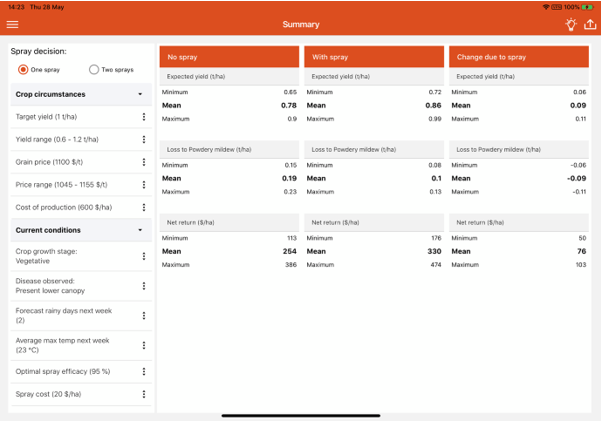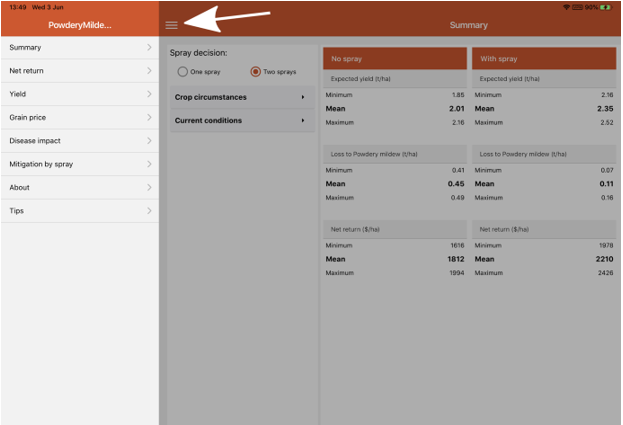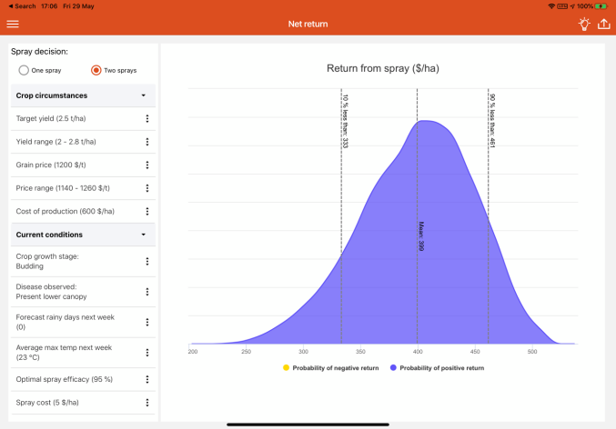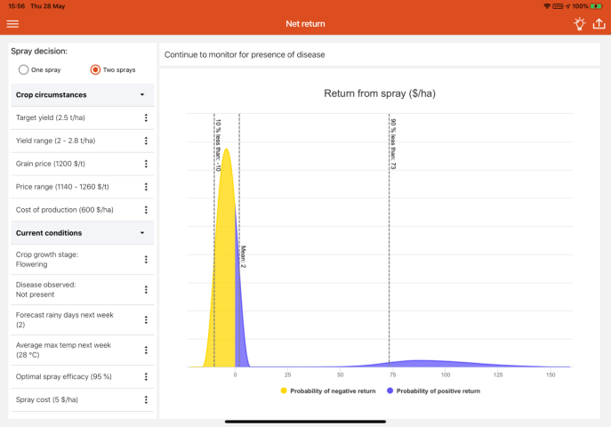Make better fungicide application decisions for mungbean powdery mildew with the new PowderyMildewMBM app
Take home message
- PowderyMildewMBM, the mungbean powdery mildew management app enables growers and advisers to explore the economics of the using fungicides to control the disease in different situations
- Good decisions are critical when making fungicide application decisions to prevent the development of fungicide resistance in the powdery mildew population; if it doesn’t pay, don’t spray
- Download PowderyMildewMBM for your tablet device from the Apple App Store or Google Play.
Powdery mildew of mungbean in Australia is one disease that is caused by two species of fungi, Podosphaera xanthii,and a second powdery mildew species, Pseudoidium sp., that has not yet been fully characterised. The disease can occur at any growth stage and develops rapidly under favourable weather conditions. Mungbeans planted late in the summer growing season tend to be more exposed to the disease as the weather conditions become more favourable for the disease. Milder temperatures and higher relative humidity are conducive conditions for the fungus to infect and reproduce. Lower leaves generally show the first signs of infection as small, white, powdery patches. Later stage infections can lead to every leaf being covered in white, powdery growth with stems and pods also being infected. Yield losses in Australia have been shown to reach 40% in varieties that are highly susceptible to the disease, e.g. Berken. Losses in currently planted varieties are not as great. The moderately susceptible variety Jade-AU, offers the best resistance to the disease. Because of the lack of resistance in currently available cultivars, fungicide treatments remain the best option for controlling this disease when it occurs.
Current control recommendations for mungbean powdery mildew are to spray at the first sign of disease with a second application two weeks later, if necessary. Although the recommendations are straightforward, many other factors enter into a decision to spray or not to spray.
Powdery mildew fungi are known to develop resistance to synthetic fungicides. In Australia, fungicide resistance in wheat and barley powdery mildew have already been identified by the Centre for Crop and Disease Management (CCDM), based at Curtin University. Overreliance on fungicides can lead to the development of fungicide resistance in powdery mildew fungi populations. Currently, only one fungicide, Custodia® (tebuconazole 200 g/L + azoxystrobin 120 g/L) has a permit allowing use on powdery mildew in mungbeans, permit number – PER82104. we encourage growers and advisors to consult with the PowderyMildewMBM app to see if a spray is economically viable. If a spray is not indicated to be economically viable because the disease is not yet present or weather conditions do not favour disease development, please do not spray. Unnecessary use of fungicides is both expensive and leads to the development of fungicide resistance and as a result, should be avoided. Good stewardship of fungicide use gives the breeding program more time to develop varietal resistance and extends the usefulness of the fungicides for continued use by the mungbean industry.
PowderyMildewMBM aims to assist fungicide application decisions, when to spray or not to spray, by presenting useful information about different situations that can influence the potential financial return of fungicide applications. Users can run several different scenarios to see what the expected payback is for different combinations of fungicide applications. It allows you to compare the profitability of zero, one, and two spray management strategies, while accounting for forecasted weather, production costs, and mungbean market values.
Mungbean powdery mildew management app – PowderyMildewMBM
PowderyMildewMBM joins a family of apps; SclerotiniaCM, for controlling canola sclerotinia stem rot; and BlacklegCM, for controlling canola blackleg. PowderyMildewMBM is the first app for a summer crop grown in the GRDC northern grains region.
PowderyMildewMBM takes account of costs, yield benefits, and grain price to give you the best case, worst case, and most likely estimates of financial return. The app allows the user to tailor each simulation for a given paddock to give custom recommendations for each paddock. Users can run as many simulations as they like to help determine their best course of action.
Figure 1. PowderyMildewMBM launches with a standard set of values that the user can modify to best represent their paddock’s circumstances.
When the user first launches the app, it starts in the summary view (above). In this view to the far left are the parameters that can be adjusted for; ’Crop circumstances‘ and ’Current conditions‘. To the right are three columns that display information regarding what the effects are of ’No spray‘, ’With spray‘ and the ’Change due to spray‘ for the currently set values.
To change values of the ’Crop circumstances‘ or the ’Current conditions‘, select the item to change, and the pop-up displays a dialogue to select the desired values. The target yield can be set from 0.5 to 4 tonnes/ha and yield range can be adjusted for wider or smaller intervals depending on experience and the current season.
In the ’Current conditions‘ section, the app offers several options to tailor the information to reflect the crop circumstances including the already incurred costs and estimated farm-gate price, as well as adjusting the volatility of the yield and price.
The current conditions are easily tailored for the crop growth stage, forecasted weather, and fungicide efficacy and costs.
Figure 2. Clicking on the ’hamburger menu icon‘, indicated by the white arrow, in the upper left reveals a hidden menu to display the information in different formats.
Clicking on the hamburger menu icon to the upper left reveals a menu of options to view different interfaces. This allows users to explore the results in different sets of graphs and tables, like ’Net return‘, (above), ’Yield‘, ’Grain price‘, ’Disease impact‘ and ’Mitigation by spray‘ which allows users to easily find the information that they are looking for in an easily interpretable interface.
Two possible use cases
To illustrate how PowderyMildewMBM might be used to provide information to a user, two case studies are provided below. The first is where two fungicide applications will be economically viable and beneficial to save mungbean yield. The second illustrates a situation where a fungicide spray is not economically viable and should not be made.
Figure 3. A possible use case showing the Net return view, showing the target (entered by the user) and expected (calculated by the app) net return resulting from zero or two fungicide applications.
Case study number 1
An app user has a paddock that will potentially yield 2.5 tonnes per hectare at a price of $1,200 per tonne. Currently, the crop is still in the vegetative stage, meaning that there is still some time left in the season for the disease to develop and the disease has been found in the lower canopy on some leaves. The app predicts that with no sprays, the mean yield would be reduced to 2.01 tonnes per hectare and with two sprays the mean net return from spraying would be $399 per hectare with no probability of a negative net return from the spray.
Figure 4. A possible use case showing the probability of an economic return of a fungicide treatment when no disease has yet been observed in the crop canopy of the paddock in question.
Case study number 2
An app user is having a good year, they are again expecting 2.5 tonnes per hectare, the crop is flowering and it is still fairly early in the season so the average temperatures for the next week are 28˚C and there has been no disease yet noted in the canopy. However, there is going to be an insecticide application, so the user is considering including a fungicide just for good measure.
Plugging these values into the app suggests that there is a far greater probability that even the costs of just the product (this time $5 per hectare) will not be recovered. The probability of a negative return is quickly seen in yellow versus the probability of a positive return in purple. A further risk is that of adding to the probability that fungicide resistance will develop in the fungal populations due to the overuse of fungicides through unnecessary applications and should be avoided. In this situation, no fungicide should be applied. The crop can then be re-examined later and if disease is observed, the app can be updated, and fungicide can be applied at that time if warranted.
Currently, the use of Custodia® for control of powdery mildew in mungbeans is covered by an APVMA permit (PER82104) that is valid until November 2022. Trials conducted by USQ in conjunction with DAF Queensland have previously shown this fungicide to be effective in controlling the disease under yield-limiting conditions.
The app has already seen use that is on par with the existing apps. After the initial launch in November 2019, which saw the biggest monthly spike in downloads of the app, there was a second spike in March 2020, which would coincide with the anticipated onset of the disease and continued use into the month of May. The app will assist advisers and growers determine whether or not the conditions warrant a fungicide application. PowderyMildewMBM is the result of over five years work with trials located at multiple locations. Research was conducted by the University of Southern Queensland (USQ) and DAF Queensland (DAFQ) across northern New South Wales and Queensland. As with the existing family of management apps, PowderyMildewMBM will continue to be developed and improved with further research. Currently, research is being conducted by USQ and Queensland DAF on possible differences from the differing powdery mildew pathogens and the influence of differing mungbean cultivars. This information will be used to enhance the app’s accuracy and value to end-users.
It is hoped that this app will be used to help make informed fungicide application decisions for mungbean powdery mildew that will help slow the development of fungicide resistance in the pathogen populations by reducing the number of unnecessary fungicide applications. Remember, if it doesn’t pay, don’t spray.
Acknowledgements
The research undertaken as part of this project is made possible by the significant contributions of growers through both trial cooperation and the support of the GRDC, the author would like to thank them for their continued support.
The authors would like to acknowledge Dr. Susan Thompson (USQ retired), Mr. Duncan Weir (DAF Queensland) and Mr. John Lehane (DAF Queensland) for their assistance in establishing and maintaining research trials associated with this research and Ms. Lisa Kelly (DAF Queensland), Professor Levente Kiss (USQ) and Mr. Andriamahery Rasolofoharivelo (USQ) for their current and future work that contributes to the understanding of the differences between the powdery mildew species and their effects on mungbean cultivars.
The authors also thank the staff at the DAF Queensland Research Facilities at Hermitage Research Facility, Warwick, Qld for their assistance in establishing research trials to evaluate this app.
Contact details
Adam H. Sparks
University of Southern Queensland, Centre for Crop Health
West St., Toowoomba, Qld 4350
Ph: 07 4631 1948
Email: adam.sparks@usq.edu.au
Varieties displaying this symbol beside them are protected under the Plant Breeders Rights Act 1994.
® Registered trademark
GRDC Project Code: DAW00228,
Was this page helpful?
YOUR FEEDBACK




